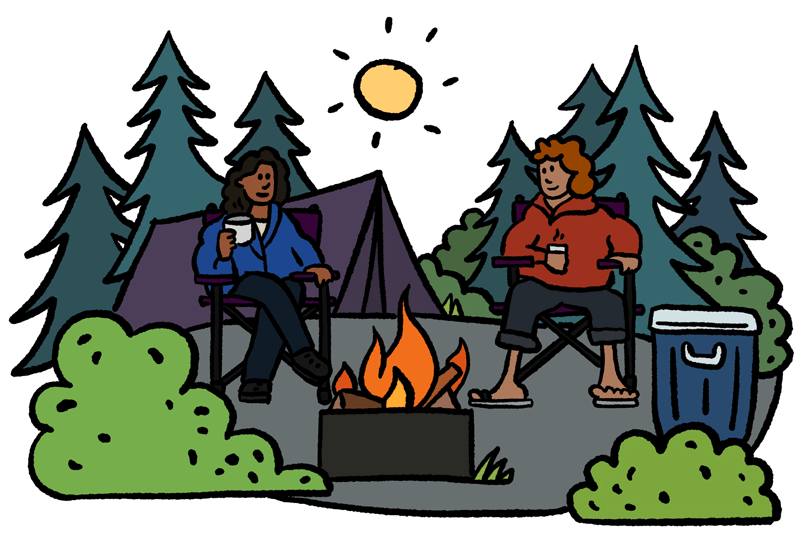Rockhound Camping
notifications Text me when there's a cancellation at Rockhound




New Mexico is a landlocked state in the Southwestern region of the United States. It is one of the Mountain States of the southern Rocky Mountains, sharing the Four Corners region with Utah, Colorado, and Arizona. It also borders the state of Texas to the east and southeast, Oklahoma to the northeast, and shares an international border with the Mexican states of Chihuahua and Sonora to the south. New Mexico's largest city is Albuquerque, and its state capital is Santa Fe, the oldest state capital in the U.S.—founded in 1610 as the government seat of Nuevo México in New Spain—and the highest in elevation, at 6,998 feet (2,133 m).
New Mexico is the fifth-largest of the fifty states by area, but with just over 2.1 million residents, ranks 36th in population and 45th in population density. Its climate and geography are highly varied, ranging from forested mountains to sparse deserts; the northern and eastern regions exhibit a colder alpine climate, while the west and south are warmer and more arid. The Rio Grande and its fertile valley runs from north-to-south, creating a riparian biome through the center of the state that supports a bosque habitat and distinct Albuquerque Basin climate. One–third of New Mexico's land is federally owned, including many protected wilderness areas, 15 national parks and monuments, and three UNESCO World Heritage Sites wholly contained within the state—the most of any U.S. state.
New Mexico's economy is highly diversified; major sectors include mining, oil and gas, aerospace, media, and film. Its total real gross domestic product (GDP) in 2023 was over $105 billion, with a GDP per capita of $49,879. New Mexico often ranks low in wealth, healthcare, and education, but has some of the highest concentrations of scientists, engineers, along with other highly skilled workers, and it includes one of the most educated counties in the U.S. (albeit very small) in Los Alamos County. New Mexico has a significant federal presence, including U.S. military installations such as White Sands Missile Range and Kirtland Air Force Base, and Department of Energy research centers such as the Sandia and Los Alamos National Laboratories. The state hosted several key facilities of the Manhattan Project, which developed the world's first atomic bomb, and was the site of the first nuclear test, Trinity.
In prehistoric times, New Mexico was home to Ancestral Puebloans, the Mogollon culture, and ancestral Ute. Navajos and Apaches arrived in the late 15th century and the Comanches in the early 18th century. The Pueblo peoples occupied several dozen villages, primarily in the Rio Grande valley of northern New Mexico. Spanish explorers and settlers arrived in the 16th century from present-day Mexico. Isolated by its rugged terrain, New Mexico was a peripheral part of the viceroyalty of New Spain. Following Mexican independence in 1821, it became an autonomous yet restive region of Mexico, with increasing economic ties to the U.S. Following the Mexican–American War in 1848, the U.S. annexed New Mexico as part of the larger New Mexico Territory, which was central to U.S. westward expansion; New Mexico was admitted to the Union as the 47th state on January 6, 1912.
New Mexico's history has contributed to its unique culture. As one of only seven majority-minority states, it has the nation's highest percentage of Hispanic and Latino Americans and second-highest percentage of Native Americans, after Alaska. The state is home to one–third of the Navajo Nation, 19 federally recognized Pueblo communities, and three federally recognized Apache tribes. Its large Latino population includes Hispanos descended Spanish era settlers, and successive groups of Mexican Americans. The New Mexican flag, which is among the most recognizable in the U.S., reflects indigenous and Spanish inspiration. The convergence of indigenous, Spanish, Mexican, and American influences is also evident in New Mexico's unique cuisine, Spanish dialect, folk music, and Pueblo Revival and Territorial styles of architecture.
We can help! Many campsite reservations are cancelled daily. Just tell us when you’d like to camp at Rockhound, and how long you want to camp for. We’ll text you when a suitable spot opens up!
Scan for cancellationsWhoops! Sometimes we make mistakes. Want to help improve the Rockhound listing? Please suggest a correction.
Open to camping at other nearby parks? Here are a few other parks you'll find in the vicinity.

How was your visit to Rockhound? Share your review of Rockhound and help fellow nature-lovers make an informed decision.
Post a reviewTell us when, where, and how long you want to camp for. We’ll notify you (via SMS) when a suitable spot opens up at that campground—so you can nab that sold-out campsite reservation!